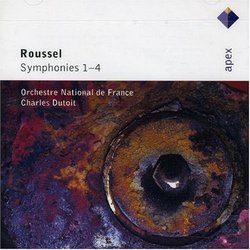| All Artists: Albert Roussel, Charles Dutoit, Orchestra National de France Title: Roussel: Symphonies 1 - 4 Members Wishing: 0 Total Copies: 0 Label: Wea Apex Classics UK Original Release Date: 1/1/2007 Re-Release Date: 6/6/2007 Album Type: Import Number of Discs: 2 SwapaCD Credits: 2 UPCs: 0825646434923, 825646434923 |
Search - Albert Roussel, Charles Dutoit, Orchestra National de France :: Roussel: Symphonies 1 - 4
 | Albert Roussel, Charles Dutoit, Orchestra National de France Roussel: Symphonies 1 - 4
|
Larger Image |
CD Details |
CD ReviewsRoussel's four fine symphonies -- a real find R. Hutchinson | a world ruled by fossil fuels and fossil minds | 02/22/2010 (5 out of 5 stars) "I only recently discovered these early 20th century symphonies when I learned that Martinu, the great Czech composer, had studied with Roussel (1869-1937). These are fine little-known works, written between 1904 and 1934. Charles Dutoit leads the Orchestre de France in excellent performances recorded in 1985. (This new Apex release is a reissue of the 1999 Erato set.) Symphony No. 1 (Le Poeme de la foret) is a lovely Impressionist piece in four movements of 35 minutes length, clearly influenced by Debussy as well as Roussel's teacher Vincent d'Indy. This is the most obscure of the four (it can also be found on the now out-of-print RCA recording led by Janowski). Symphony No. 2 was written in 1919 and is darker in tone, reflecting Roussel's wartime experience. Roussel served voluntarily, despite his age. I find this to be a most impressive work, but it was not a success and is rarely heard. In three movements of 37 minutes duration, it is the longest, most complex and difficult of Roussel's symphonies. It was considered too gloomy and austere by a public eager to move on from the Great War, but I think it is revealed today to be at least the equal of Roussel's Fourth, and I would argue closer in quality to his symphonic masterpiece, the Third. It can be found not only on the Janowski set, but also the recent EMI Gemini set, led by Pierre Dervaux, along with Andre Cluytens leading the 3rd & 4th. Symphony No. 3 was commissioned for the 50th anniversary of the Boston Philharmonic Orchestra by its legendary conductor Serge Koussevitzky, and he led its triumphant premiere in Boston on October 24th, 1930. It is a tremendously vivacious piece, leading off with a five-note motif in a distinctive dance/march rhythm that seems to have been in Martinu's head when he composed his similarly energetic 4th Symphony in 1945. The Third Symphony moves irresistably across four movements of 24 minutes length. Surely Roussel's best known work, it is more than deserving of its popularity. Some maintain that the Boulez recording with the New York Philharmonic is the best available recording, but it's hard to imagine a better performance than Dutoit's. Its reception bolstered Roussel, who wrote one more symphony a few years later in 1934. Symphony No. 4 was written easily and quickly in only five months from August to December. Another four-movement work, it is is 21 minutes long, and similar to the Third in its classical and impressively balanced form. The Cluytens recordings of Roussel's Third and Fourth Symphonies have now been repackaged again by EMI in its 20th Century Classics series. This bargain Apex set has the clear advantage of including all four symphonies, especially the superb Symphony No. 2. If you really fall for Roussel's symphonies you may want to hear the new cycle from Eschenbach on Ondine leading the Orchestre de Paris -- Symphony 1 "Le Poème de la forêt" and Symphony 4, Symphony 3 and "Le Festin de l'araignée" and Symphony 2 and "Bacchus et Ariane". Eschenbach considers Roussel's Second to be a 20th century masterpiece." Roussel by Dutoit Carlos Quintero | Caracas, Venezuela | 09/19/2009 (5 out of 5 stars) "
Very nice to know the complete Roussel symphonies. I think the Nrs. 1 and 2 are much better than more famous Nr.3. Dutoit conducts with real conviction and deliver a splendid symphonic cycle. This is the cycle to get." |

 Track Listings (4) - Disc #1
Track Listings (4) - Disc #1